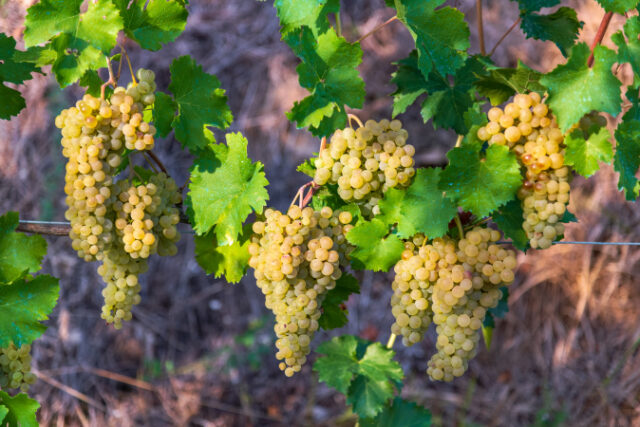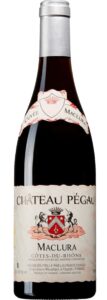
By Tom Marquardt And Patrick Darr
The Rhone Valley is the third largest appellation in France, behind Languedoc-Roussillon and Bordeaux. The region in southern France churns out oceans of refreshing red, rosé, and white wines. Those wines from its largest sub-appellation, the Cotes-du-Rhone, are abundant and usually economically priced for wise shoppers. That’s why we turn to Cotes-du-Rhone whenever confronted by a wine list dominated by expensive wines or unknown wines. It’s a safe harbor in a storm.
Grenache, syrah and mourvedre are the red grapes that dominate blends conforming to AOC regulations on yields, percentage of grape varieties and alcohol levels. But these primary varieties are augmented by many others, including cinsault, counoise, and carignane, that play supporting roles in a broadly nuanced wine.
White blends incorporate marsanne, roussanne, clairette, viognier, bourboulenc and other varieties.
The warmer weather of this southern region benefits from a Mistral wind that keeps the grapes dry and help to reduce the diseases that like moisture.
The higher hierarchy of the AOC wines includes the Cotes-du-Rhone villages, the wines named after a village, such as our favorite Rasteau, and finally the 17 cru wines that include Cornas, St. Joseph, Gigondas, and Vacqueyras. We love the crus – especially Gigondas and Vacqueryas — but they are more expensive. The villages represent the best values from the Rhone Valley.
We recently tasted several Cotes-Du-Rhone wines that would be an excellent and relatively inexpensive match to grilled foods, ranging from ribs to chicken. These wines generally have good acidity to offset citrus sauces and juicy flavors to complement fatty entrees like ribs and burgers.

One of two rosés we enjoyed was the 2024 Chevalier d’Anthelme Côtes-du-Rhône Rosé ($20). A blend of 60 percent cinsault and equal parts marsanne and grenache this is a bright fruity rosé with berry and cherry notes, and is a mouth-filling experience.
The other rosé was the 2024 Gabriel Meffre Terres de Galets Cotes-du-Rhone Rosé ($10-15). A blend of grenache and syrah, it has a light pink color with fresh strawberry and cherry notes. Very lively and pleasant.
For something different, try the Jean-Luc Colombo Les Abeilles Cotes-du-Rhone Blanc 2022 ($18). We don’t take many opportunities to taste the white wines from this region of the Cotes-du-Rhone, but we should. This is a good example of what the white grape varieties can deliver in the summer. Made up of clairette and roussanne, the wine has fresh floral aromas with lean, citrus flavors, bright acidity, and a mineral backbone.
We also tasted several red Cotes-du-Rhones that varied significantly.
90+ Cellars Classic Series Cotes-du-Rhone Red 2023 ($12-15). A very satisfying red with grapey and ripe strawberry elements and a hint of oak.

Paul Jaboulet Aine Parallele 45 Cotes-du-Rhone Red 2023 ($12-15). Mostly grenache and syrah with a dash of marselan and carignan. A bright, fresh style with cherry and berry notes in a delightful package.
M. Chapoutier Belleruche Cotes-du-Rhone 2024 ($15-20). Mostly plum and cherry notes that seemed undeveloped on the palate. Promises to bloom over time.
Chateau Pegau Cuvee Maclura Cotes-du-Rhone 2022 ($25). A classic, bold, elegant, and complex blend of grenache, syrah, mourvedre and cinsault. Ripe cherry and strawberry flavors remind us of a mini-Chateauneuf-du-Pape.
Saint Cosme Cotes-du-Rhone 2022 ($18). It’s unusual to find a Cotes-du-Rhone made entirely from one grape variety, but this all-syrah monster doesn’t need any help. Great structure with ripe plum flavors and layers of dried herbs, black pepper and mineral. It is definitely a wine to pair with grilled beef.
Domaine Ott
Rosés from Southern France generally fall into a consumer-friendly price zone more often than not, priced in the $15 and lower $20 range. The rosés from the Provence region are today much in fashion and appear on many restaurant wine lists.
We strongly advocate that rosé should be considered year-round. After all consumers don’t suddenly lose interest in chardonnay and sauvignon blanc outside of warm weather months. Their crisp freshness and general food adaptability make them a wise choice for winter soups and charcuterie trays as well as a potential consensus builder at Thanksgiving dinner.
Two years ago, we were in Provence and had the privilege of meeting Jean-Francois Ott, the fourth generation to be making wine for this historic property. We tasted through his extensive portfolio and were impressed with how determined he is to maintain the property’s standard of making complex and age-worthy wines.

The producer’s three estates are located in Provence and Bandol. The classical grapes of the two regions include grenache, syrah, cinsault and mourvedre. All of their vineyards are certified organic. Roederer Collection, owners of a myriad of prestigious international wine brands, purchased a majority interest the Domaine Ott Estates in 2004, although the Ott family maintains an interest in managing the overall operation.
The two rosés we tasted from Domaine Ott sport premium prices in the $60-70 range and consumers can determine whether they are worth it. We enjoyed their elegance, understated fruit and overall quality.
Domaine Ott Château De Selle Côtes De Provence 2024. Smooth, slightly lighter in color than the two samples, with light peach and white plum notes.
Domaine Ott Chateau Romassan Bandol 2024. A bit bigger and more complex than the Cotes de Provence version. Citrus, peach, and honeydew melon in an elegant, smooth package.
Wine picks
San Felice Chianti Classico Borgo 2022 ($33). Simple but delicious flavors of cherry and raspberries. Floral aromas and balanced acidity.
Castello Nipozzano Chianti Rufina Riserva DOCG 2021 ($19). Aromas of blueberries, violets, pepper and spice give way to fresh red fruit and citrus flavors. Smooth texture is inviting to the senses.
Disclaimer
The information contained in South Florida Reporter is for general information purposes only.
The South Florida Reporter assumes no responsibility for errors or omissions in the contents of the Service.
In no event shall the South Florida Reporter be liable for any special, direct, indirect, consequential, or incidental damages or any damages whatsoever, whether in an action of contract, negligence or other tort, arising out of or in connection with the use of the Service or the contents of the Service. The Company reserves the right to make additions, deletions, or modifications to the contents of the Service at any time without prior notice.
The Company does not warrant that the Service is free of viruses or other harmful components












